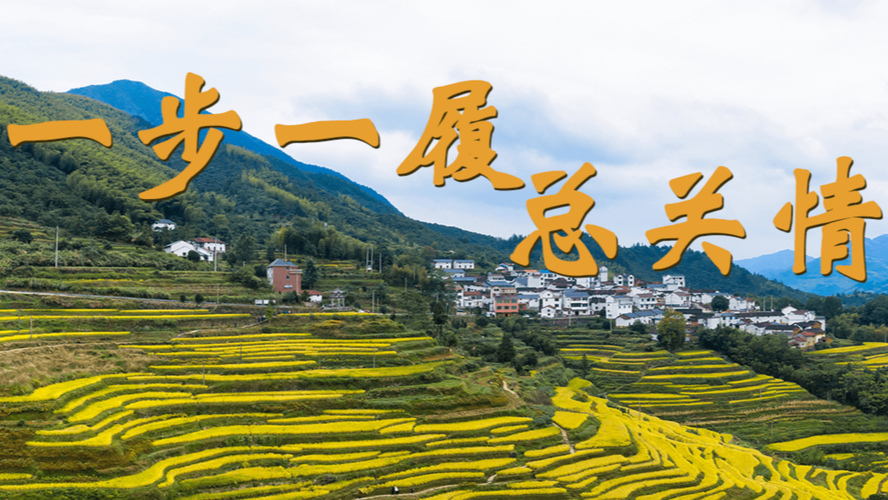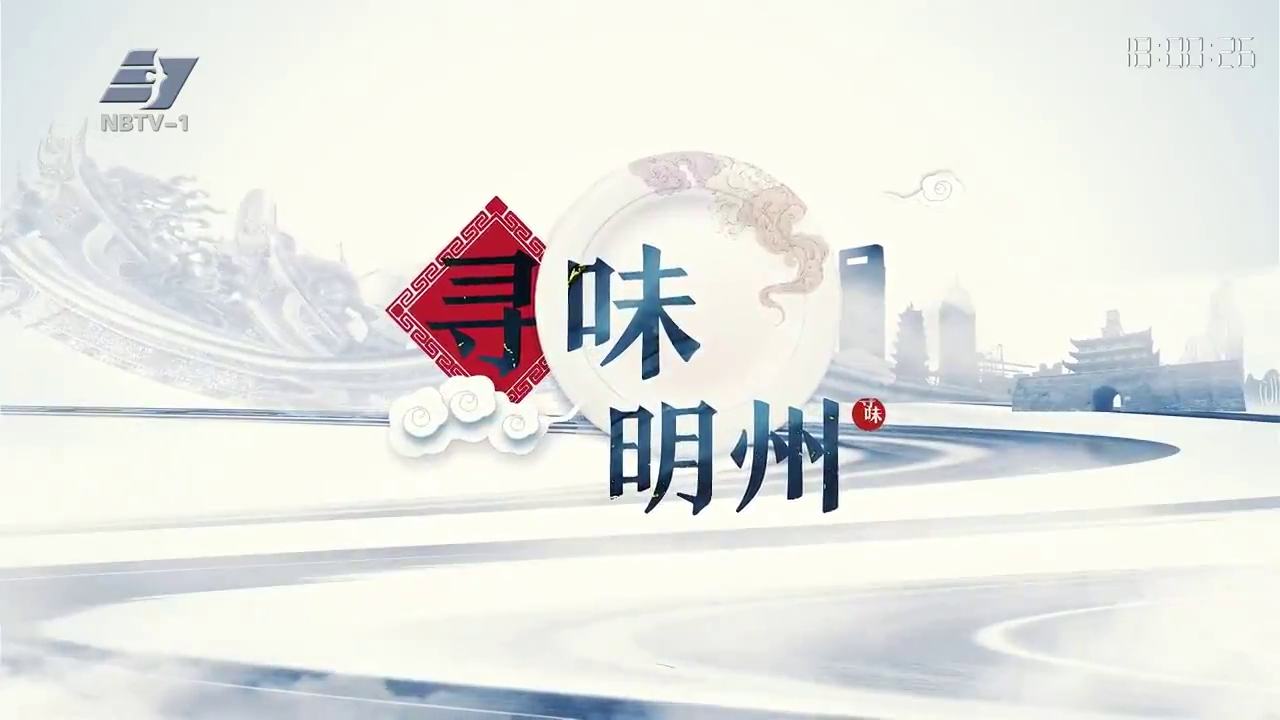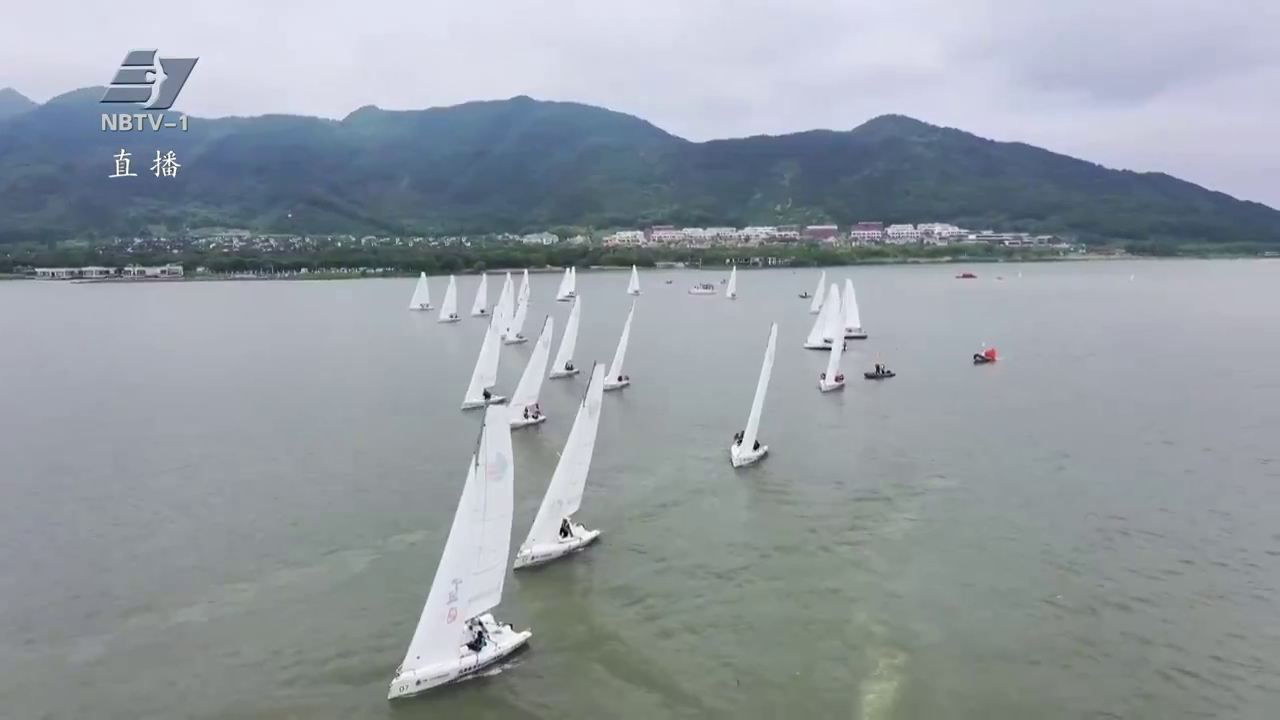
书藏古今,港通天下。宁波是一座向海而生,因港而兴的城市。为了向世界讲好宁波故事,宁波发布推出“双语宁波”栏目,围绕历史、地理、人文、经济等多个方面聚焦“世界的宁波,宁波的世界”。
作为海上丝绸之路的起点城市之一,宁波自古就和世界各地往来密切。我们跟着宁波晚报“外国档案里的宁波”栏目,带大家换个视角,看看外国档案里的宁波是什么样子?
88年前,他将上林湖越窑遗址推向世界!这份前缘能否再续?
88 Years Ago, He Introduced the Shanglin Lake Yue Kiln Site to the World! Can This Predecessor Bond Be Renewed?
位于浙江宁波北部的慈溪有着中国“秘色瓷都”的美誉,这里的越窑始于东汉,终于南宋,绵延千年,是中国持续时间最长的窑系。越窑集中地上林湖被称为世界最大的“露天青瓷博物馆”,也是皇室御用“秘色瓷”的唯一原产地。
Cixi County, located in the northern part of Ningbo City, Zhejiang Province, is renowned as “the capital of Mi-se Porcelain” in China. The Yue Kilns here represents the longest-lasting cluster of kilns in China, spanning over a thousand years from the Eastern Han Dynasty (25-220 AD) to the Southern Song Dynasty (1127-1279 AD). Shanglin Lake, home to most of the Yue Kilns, is celebrated as the world’s largest open-air celadon museum and the sole origin of the imperial Mi-se Porcelain.
1935年7月,美国人普拉玛(美国著名古陶瓷学家,密歇根大学亚洲艺术教授)从上海辗转来到慈溪上林湖考察,拍下了若干张越窑遗址照片,并于一年半后,在国际刊物上发出了这些照片和三篇文章,系统性地向世界介绍上林湖与越窑秘色瓷。
In July 1935, James Marshall Plumer (1899-1960), a renowned American ancient ceramics scholar and Professor of Asian Art at the University of Michigan, traveled to Shanglin Lake in Cixi from Shanghai and conducted field investigations. He took several photographs of the Yue Kiln site and, a year and a half later, published these images alongside three academic papers in international journals, systematically introducing Shanglin Lake and the secret-color porcelain of the Yue Kiln to the world.
从现有研究来看,普拉玛是第一位实地考察研究上林湖越窑遗址的西方学者。
According to existing research, Plumer was the first Western scholar to conduct on-site investigations and studies of the Shanglin Lake Yue Kiln site.
陶瓷研究者惊叹秘色瓷小屋
Researcher awed by“The capital of Mi-se Porcelain”
普拉玛于1921年获得哈佛大学学士学位,1923年加入中国海关,曾在上海等多地工作。普拉玛和妻子卡萝的共同爱好是寻访各地古窑址收集瓷片。
Plumer, a Harvard graduate of 1921, joined the Customs Service in China in 1923. He worked in several cities, including Shanghai. James and his wife Carol shared a hobby of visiting ancient kiln sites to collect porcelain shards.
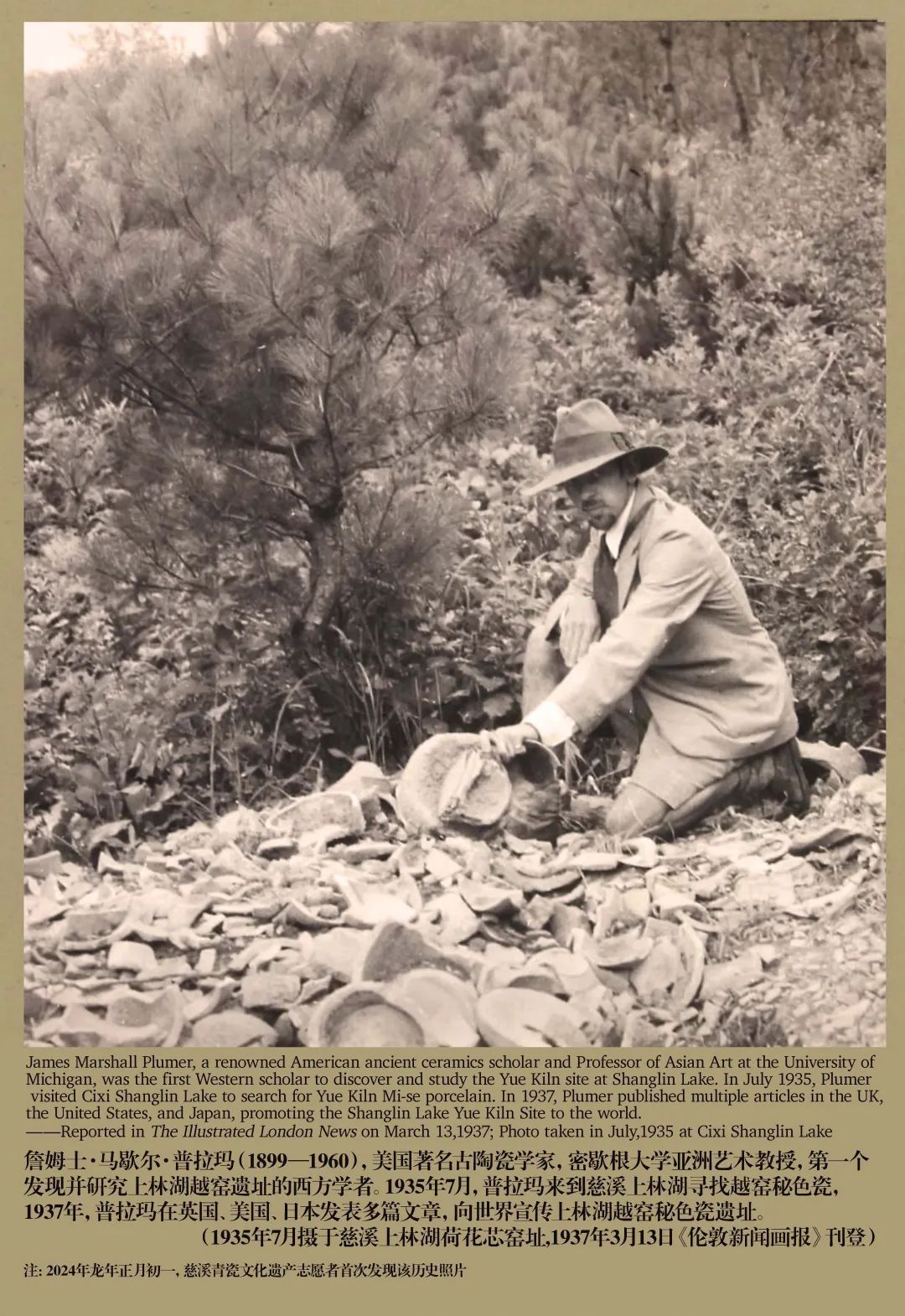
1935年5月15日,被后人尊称为“中国陶瓷考古之父”的陈万里首次踏上了上林湖这片土地,成为第一个实地调查研究越窑窑址的中国学者。同年7月,普拉玛也来到上林湖考察。
On May 15, 1935, Chen Wanli, honored as the “father of Chinese ceramic archaeology”, arrived at Shanglin Lake for the first time, becoming the first Chinese scholar to investigate the Yue Kilns site. Coincidentally, Plumer traveled to the same area in July of the same year.
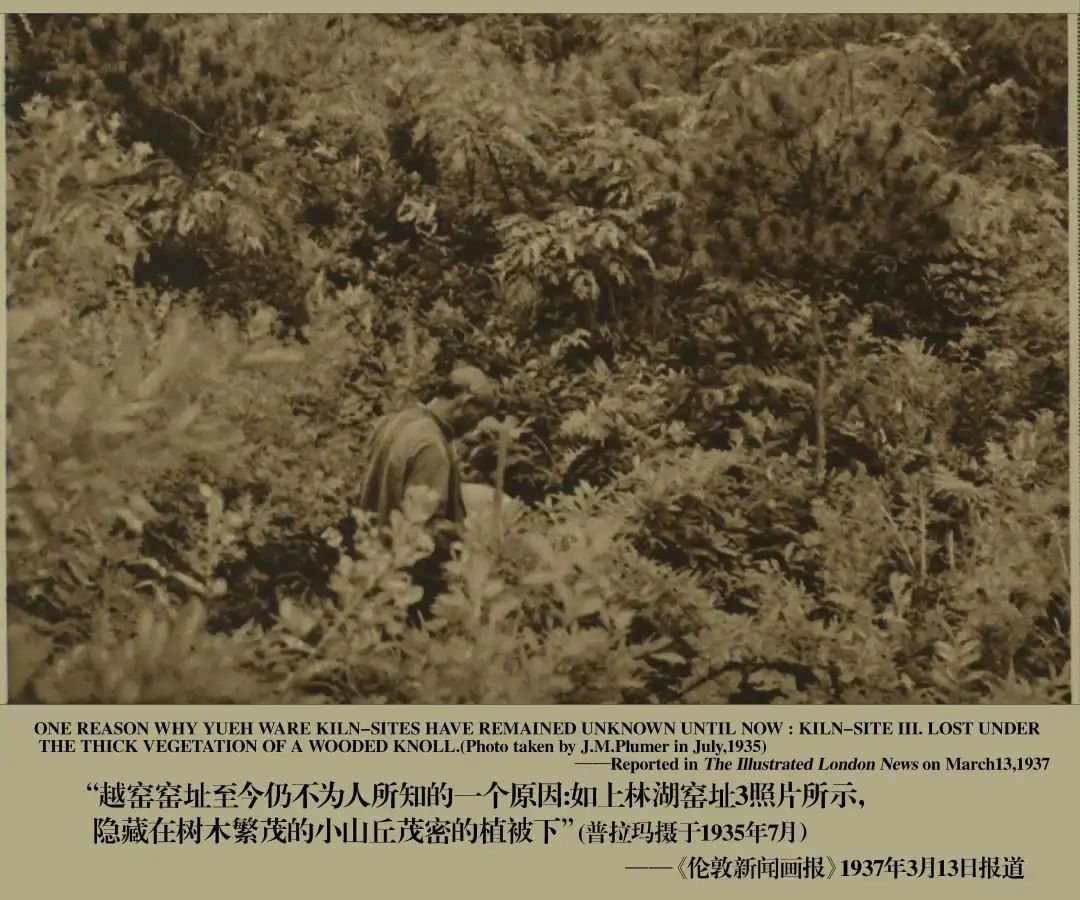
普拉玛是如何来到上林湖的?他发表的三篇关于上林湖秘色瓷的文章中,首篇对此有详细记述。
Why did Plumer decide to go to Shanglin Lake? He gives a detailed account in the first of three articles he published on the Mi-se Porcelain of Shanglin Lake.
1935年春天,一个中国朋友给了他三件相似的灰绿釉瓷片,说是窑址里出的,但窑址在哪儿不得而知。追根溯源,普拉玛得知这些瓷片来自杭州周边。普拉玛从上海到了杭州,并打听到了上林湖的位置,在时任之江大学校长的美国人费佩德和身处余姚的传教士邓肯共同协助下,于1935年7月上旬来到了上林湖南岸调研。
In the spring of 1935, a Chinese friend gave Plumer three pieces of gray-green glazed porcelain that closely resembled each other, claiming they were from an unknown kiln site. After research, Plumer discovered that these pieces originated from an area near Hangzhou. Determined to pinpoint the exact location, Plumer traveled from Shanghai to Hangzhou and managed to find out about Shanglin Lake. With assistance from Robert Ferris Fitch, president of Hangchow Christian College, and a missionary in Yuyao, Plumer arrived at the south bank of Shanglin Lake in early July 1935.
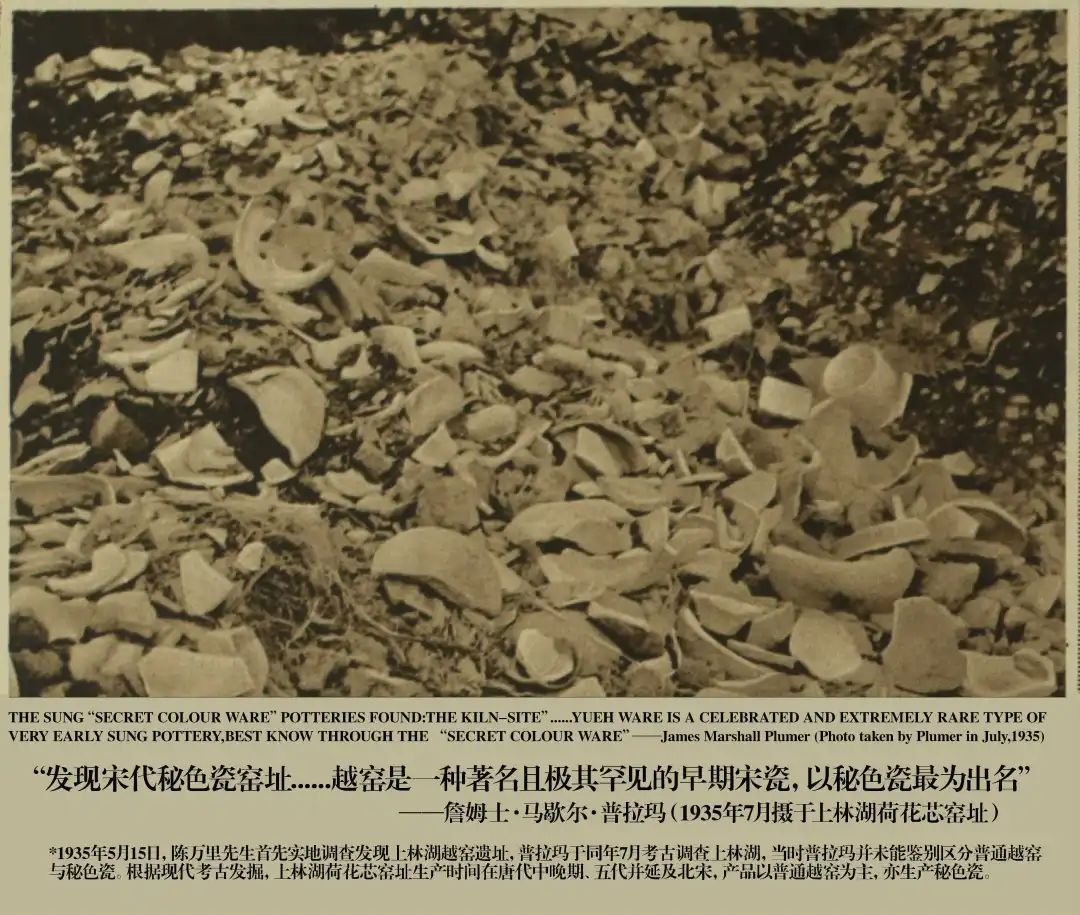
普拉玛在这篇文章中还写道:“迄今为止,外界对制造著名越窑瓷器的上林湖遗址知之甚少。”可见,当时很少有人知道上林湖是越窑秘色瓷的故乡。
Plumer wrote, “As yet, the outer world knows little of the site at Shang Lin Hu, where the famous Yueh ware was made.” Evidently, few of his contemporaries were aware that Shanglin Lake was the home of the Yue Kilns’ Mi-se Porcelain.
普拉玛在上林湖看到了什么?从他发表在刊物上的照片可窥一斑。在一张照片中,普拉玛将自己的帽子作为参照物放在破碎的瓷器匣钵中间,这些瓷片大小一般是帽子的三分之一大,层层叠叠地挤在一起。
What did Plumer see at Shanglin Lake? The photos he published can reveal the story. In one photo, Plumer placed his hat as a reference in the middle of a broken porcelain sagger. The shards within the sagger appeared to be mostly one-third the size of the hat.

另一张照片上,生活在越窑遗址附近的村民正在走动,他们身后的房子整面墙都是用瓷片垒起来的。普拉玛将这样的房子称为秘色瓷小屋,他惊叹道:只有德国梅森瓷器或法国塞夫勒皇室瓷器碎片盖的小屋可以与之相提并论。
In another photo, villagers near the Shanglin Lake Yue Kiln Site stroll about, with an entire wall of a house behind them constructed from porcelain fragments. Plumer dubbed such a structure a “Mi-se Porcelain hut”, noting that such a rare sight could only be found in Germany’s Meissen and France’s Sèvres.
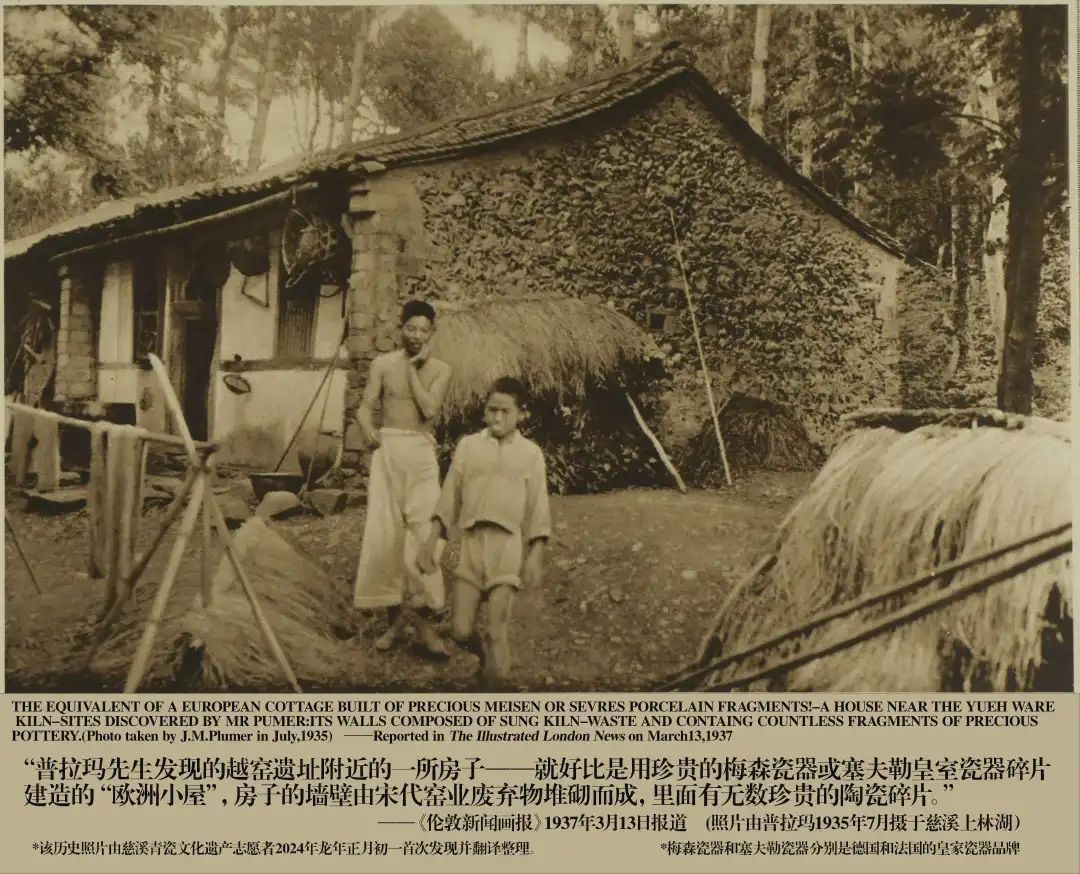
普拉玛此行发现了三个窑址,他在发表的文章中都标出了位置。根据普拉玛考察线路以及山形对比,青瓷文化志愿者徐伟明和慈溪越窑研究专家确认其中一个是荷花芯窑址,另外两个已经被新建村庄和道路掩盖。
On his trip, Plumer discovered three ancient kilns, which he marked on a map in his published article. Using Plumer’s route and landscape feature comparisons, Xu Weiming,a volunteer for celadon cultureand other Yue Kiln researchers in Cixi confirmed that one of them is the Hehuaxin kiln, which still exists. The other two, however, have since been covered by new villages and roads.
三篇文章将上林湖越窑遗址推向世界
Three Articles Bring Global Attention
普拉玛对上林湖越窑遗址考察的第一篇报告刊登在1937年3月13日出版的英国《伦敦新闻画报》上,文章标题是《消失已久的浙江窑址,珍贵的宋代陶瓷被挖掘出来用作建筑材料》,副标题是《发现世界著名的秘色瓷源头》,这篇文章披露了普拉玛在越窑窑址的考察过程。
Plumer's first report on the investigation of the Yue Kiln sites at Shanglin Lake was appeared in the March 13, 1937 issue of The Illustrated London News, with the title “Long-Lost Chekiang Kiln-Sites, Where Precious Sung Pottery is Dug out for Building Material!” and the subtitle “The Origin of the World-Famous ‘Secret Colour’ Ware Discovered”. This article explains studies Plumer conducted at the Shanglin Lake Yue Kiln Site.

此前,虽有人留下上林湖的湖景照,窑址模糊不清,在这篇文章中发布的照片是清晰的窑址照,填补了20世纪30年代上林湖窑址影像空白。
Previously, although some people left photos of the lake view of Shanglin Lake, the kiln sites were blurred. The photographs in Plumer’s article provide a clear view of the sites, offering their first known images from the 1930s.
他在1937年3月20日的《伦敦新闻画报》上,又发表标题为《发现著名的宋代秘色瓷源头》、副标题为《珍贵的越窑瓷片,包括在中国发现的最早的纪年铭文瓷》一文。
In the March 20, 1937 issue of The Illustrated London News, Plumer published an article titled “The Source of the Celebrated Sung ‘Secret Colour’ Ware Discovered”, with the subtitle “Precious Yueh Shards, Including the Earliest Pottery Dating Found in China”.
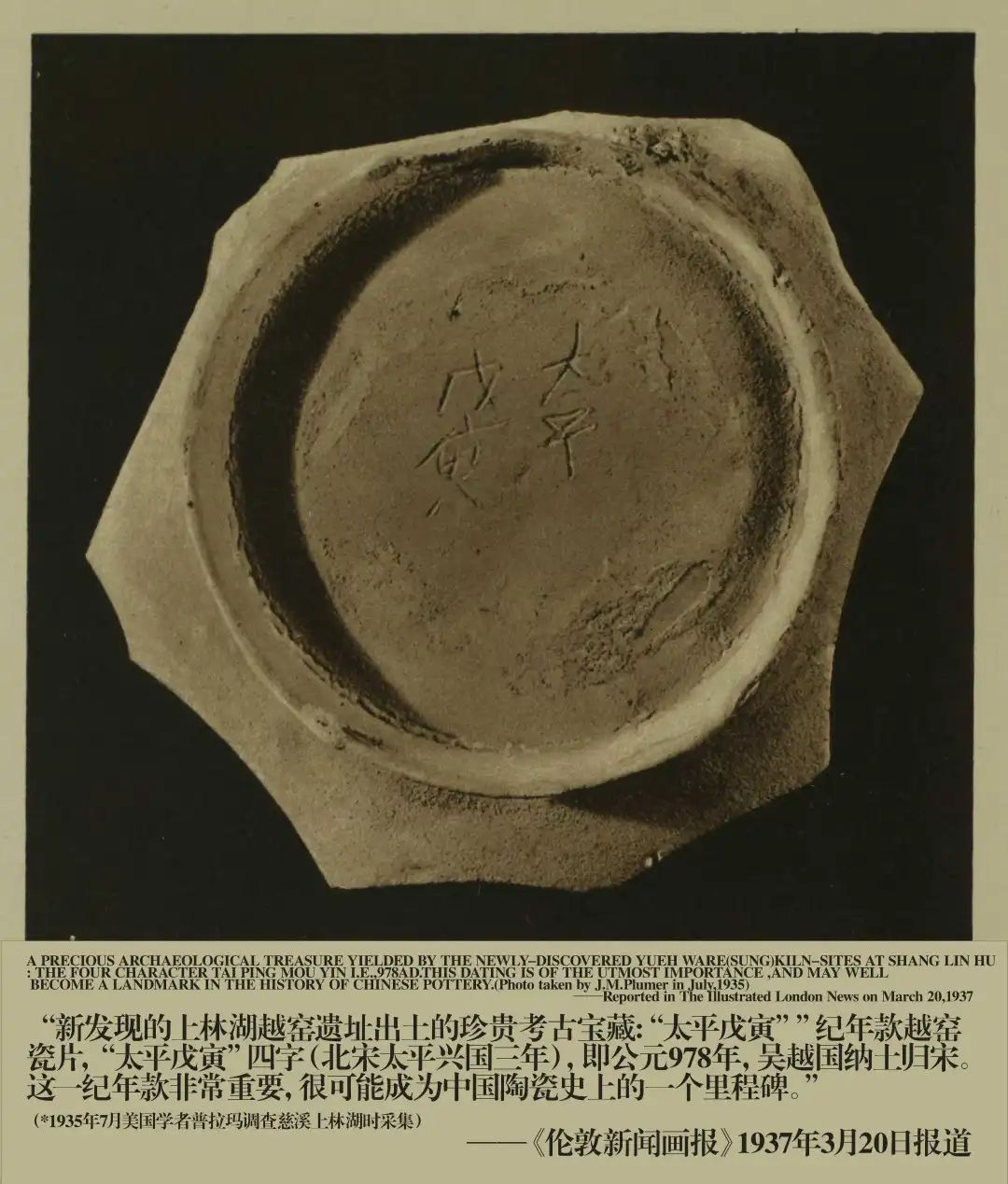
1937年下半年,普拉玛又在美国《伊斯兰艺术》上发表了题为《一些来自萨马拉的青瓷碎片找到了它们的来源》的文章。他表示“一些萨马拉遗址发掘的青瓷片不仅被证实是一种珍稀的中国陶瓷——越窑或秘色瓷,而且可以追索到这些瓷器的源头制造地——浙江宁波附近的一个小湖,上林湖的南岸”。也就是说,他确认了在伊拉克发现的瓷片来自上林湖。普拉玛的观点后被当代考古学家证实。
In late 1937, Plumer released yet another article titled “Certain Celadon Potsherds from Samarra Traced to Their Source” in the American publication Ars Islamica. He stated that “...several of the celadon shards from Samarra may not only now be identified with one of the rarest Chinese wares, the ware of Yueh or pi-se-yao, but that they many also be traced to their original place of manufacture on the southern shores of a small lake, the Shang Lin Hu, near Ningpo, Chekiang.” In other words, Plumer believed that certain porcelain shards found in Iraq came from Shanglin Lake. Plumer’s view was later confirmed by contemporary archaeologists.
可见,唐宋时期,越窑青瓷在上林湖及周边烧制好后,从明州港被运走,送往亚洲各地。也正因为如此,普拉玛对上林湖越窑遗址的文化价值予以了高度评价,“无论怎么强调这个越窑窑址的重要性都不为过。进一步的调查,包括系统性的考古发掘,有望填补中国陶瓷史上的巨大空白。”
It can be inferred that during the Tang and Song dynasties, Yue Kiln celadon was produced at Shanglin Lake and its surrounding regions, then shipped from the port of Mingzhou to various parts of Asia. It was for this reason that Plumer attached high cultural value to the Yue Kiln sites at Shanglin Lake. “It is well-nigh impossible to over-emphasize the significance of this Yueh ware site. Further investigation, including, it is to be hoped, systematic excavation, promises to fill in a tremendous gap in the history of Chinese ceramics.”

当三篇文章静静地躺在文献中时,有人在努力探寻上林湖越窑秘色瓷遗址的海外传播路径。这个人就是徐伟明。
While the three articles lay awaiting discovery in the archives, Xu Weiming worked to bring global recognition to the Shanglin Lake Yue Kiln Site.
徐伟明喜欢越窑青瓷已多年,2021年,他从一位北京建盏爱好者分享的图片中偶然发现了普拉玛来过上林湖的线索,但是得到的信息很有限。去年正月初一,他在检索英文学术文献库的时候发现了普拉玛介绍上林湖越窑遗址的文章,特别是第一次发现普拉玛本人在上林湖荷花芯窑址拍摄的照片,部分照片此前从未在国内期刊文献报道中看到过,弥足珍贵。
Xu has had a long-standing passion for Yue Kiln celadon.In 2021, he discovered clues that Plumer had visited Shanglin Lake from pictures shared by a porcelain teacup collector in Beijing, though the details were scant.On Chinese New Year 2024, Xu made a significant breakthrough while looking up information in English-language academic archives. He found Plumer’s earliest article introducing the Yue Kiln site at Shanglin Lake and, for the first time, uncovered Plumer’s photographs from the Hehuaxin Kiln site (named “Kiln-Site I” by Plumer), some of which had never been seen in Chinese publications. These images, taken in July 1935, are of immense historical value.
志愿者希望普拉玛后人来慈溪
An Invitation to Plumer’s Descendants
在徐伟明看来,根据今天的考古研究成果,普拉玛当初发表的一些学术观点也有不足或偏颇。
Xu points out that some of Plumer’s statements are inaccurate based on today’s archaeological findings.
比如,普拉玛分享的瓷器标本照片中把荷花芯窑址处收集的数件唐代越瓷说成宋代,把一件龙泉五管瓶明器说成产自越窑。但整体而言,普拉玛对上林湖越窑与秘色瓷的研究领先于他所处的时代。
For instance, in the captions of porcelain shard photographs, Plumer described several Tang Dynasty Yue porcelain pieces from the Hehuaxin Kiln site as being from the Song Dynasty. He also mistakenly identified a five-duct ware, a burial offering made in Longquan, Zhejiang, as originating from the Yue Kiln. However, Xu acknowledges that overall, Plumer’s research on the Yue Kilns and Mi-se Porcelain of Shanglin Lake was far ahead of his time.
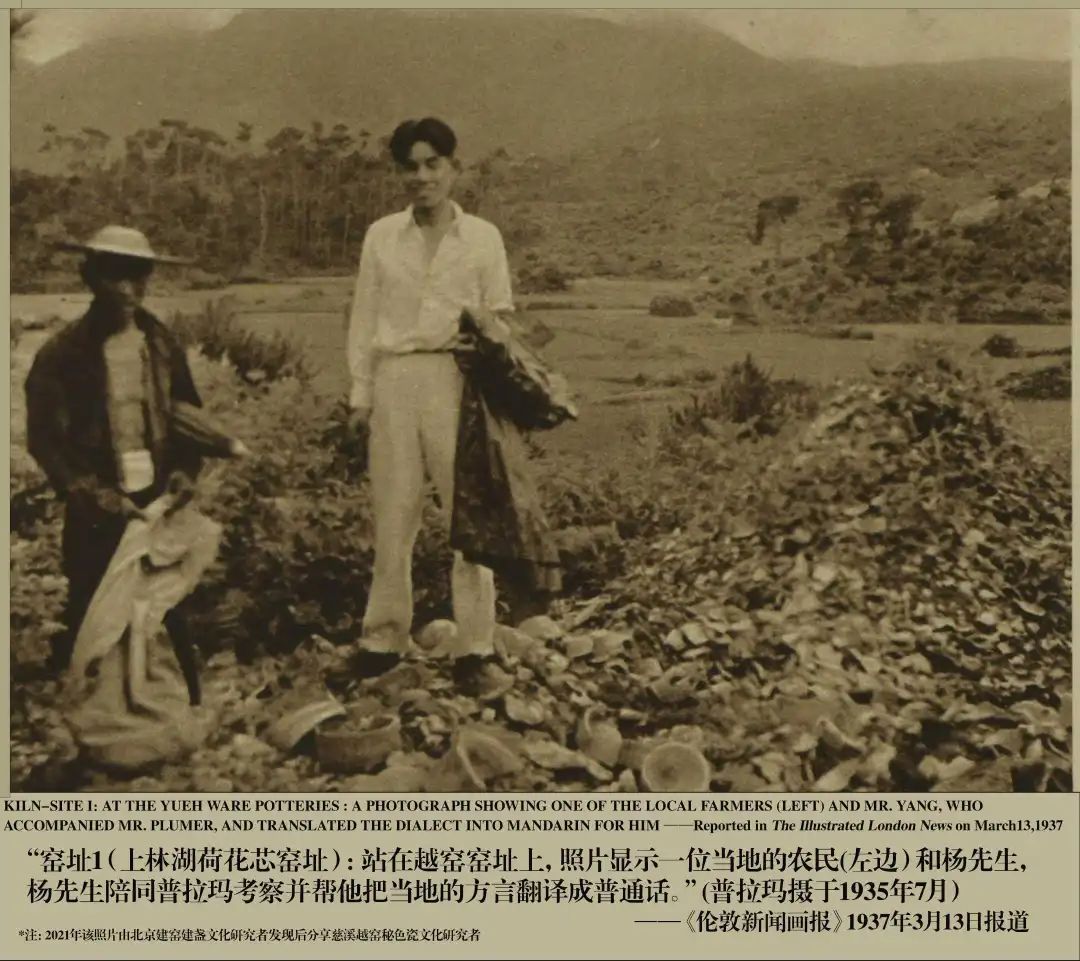
普拉玛用三篇文章,将上林湖越窑遗址推向了世界。这三篇文章既有在英国发表的,也有在美国发表的,其中两篇还被翻译成了日文刊登,这些都让上林湖越窑遗址以及越窑秘色瓷得到广泛传播。他的文章还为上林湖引来了一些国际陶瓷研究者,为秘色瓷文化遗产赢得了国际关注。
Plumer brought global attention to the Shanglin Lake Yue Kiln Site through his three articles published in both the UK and the US, with two translated into Japanese. These publications not only disseminated knowledge about the Shanglin Lake Yue Kiln Site and its Mi-se Porcelain but also attracted international ceramic researchers to Shanglin Lake, garnering widespread recognition for this cultural heritage.
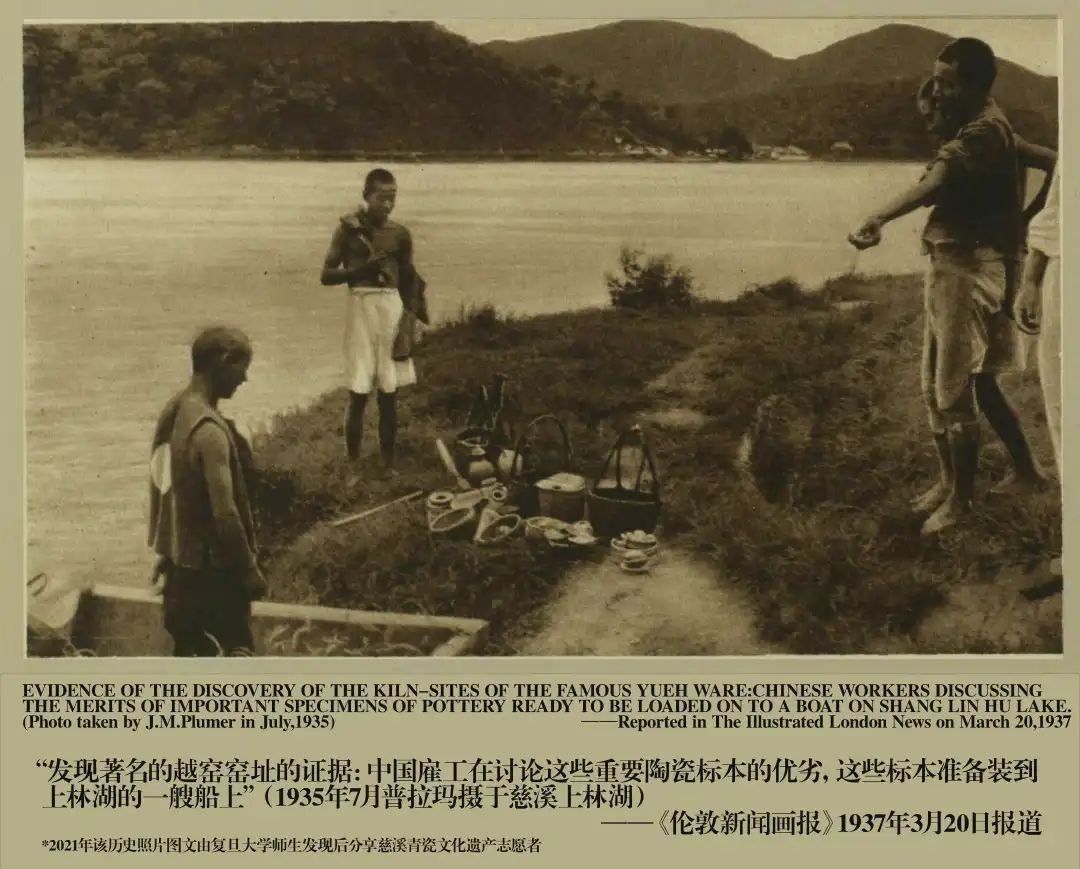
令人振奋的是,徐伟明还通过上海纽约大学艺术史副教授左拉拉的研究发现了普拉玛在二战中的这段历史贡献。
It is exciting that through the research of Lala Zuo, Associate Professor of Art History at New York University Shanghai, Xu Weiming also discovered Plama's historical contributions during World War II.
由于普拉玛对中国的了解,二战期间,他与以梁思成为代表的学者开展合作,完成了《中国古迹地图及清单》,呈送给了陈纳德将军的美军第14航空队指挥部,为中国战区的文物与古迹免遭空袭破坏做出了新的贡献,他也被授予“古迹卫士”。
Due to Plumer’s extensive knowledge of China, during World War II, he collaborated with Liang Sicheng, the renowned Chinese architecture historian, and other Chinese and American scholars to complete the “Map and List of Chinese Heritage Sites”. This map was presented to Major General Claire Lee Chennault’s 14th U.S. Army Air Force Command, aiding in the protection of cultural relics and heritage sites from air raids in the China war zone. For this invaluable contribution, he earned the title “Defender of Heritage”.
1960年6月15日普拉玛去世后,他在上林湖越窑遗址采集的标本留在了密歇根大学安娜堡校区的艺术博物院、人类学考古博物馆、凯尔西考古博物馆和哈佛大学艺术博物馆。
After Plumer’s death on June 15, 1960, the Yue Kilns porcelain shards he collected from Shanglin Lake remained in the collections of the Museum of Art, the Museum of Anthropological Archaeology, and the Kelsey Museum of Archaeology on the Ann Arbor campus of the University of Michigan, as well as the Harvard University Art Museum.
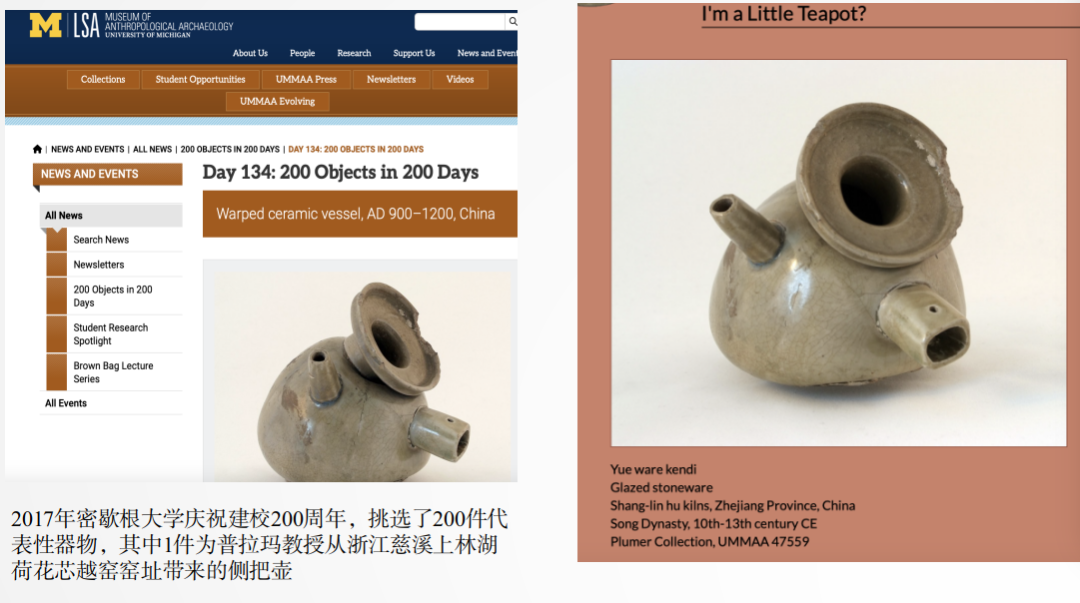
2017年密歇根大学庆祝建校200周年,精选了200件学校收藏的代表性历史器物并展览,其中1件为普拉玛教授20世纪30年代从浙江慈溪上林湖荷花芯越窑窑址带回的侧把壶。
In 2017, the University of Michigan celebrated its 200th anniversary by selecting and exhibiting 200 representative historical artifacts from its collections. Among them was a side-handle teapot brought back by Professor Plama in the 1930s from the Hehuaxin Yue Kiln site in Shanglin Lake, Cixi, Zhejiang.
“我希望密歇根大学的这些博物馆能和我们慈溪的越窑青瓷博物馆成为友好姊妹馆,共同推进越窑秘色瓷的研究,也希望找到普拉玛的后人,请他们到上林湖来看看,让普拉玛家族和上林湖再续前缘。”
“I hope that these museums at the University of Michigan could consider forming a partnership with Cixi’s Yue Kiln Celadon Museum to jointly advance the research of Yue Kiln Mi-se Porcelain. Additionally, I hope to find the descendants of Plumer and invite them to visit Shanglin Lake, so that the Plumer family and Shanglin Lake could continue our friendship.”
在徐伟明看来,再美的越窑青瓷也是器物,而器物背后的人,才是有温度的、多彩的。
In Xu’s view, even the most exquisite Yue Kiln celadon is just an object; it is the people behind these artifacts that imbue them with warmth and vibrancy.
封面/题图:宁波发布特约摄影师 沈赞赞
文字:杨静雅、崔引 翻译:潘雯婕、王思喻
鸣谢:宁波大学浙江翻译研究院
编辑:裘新蕾
来源:宁波发布、宁波晚报



